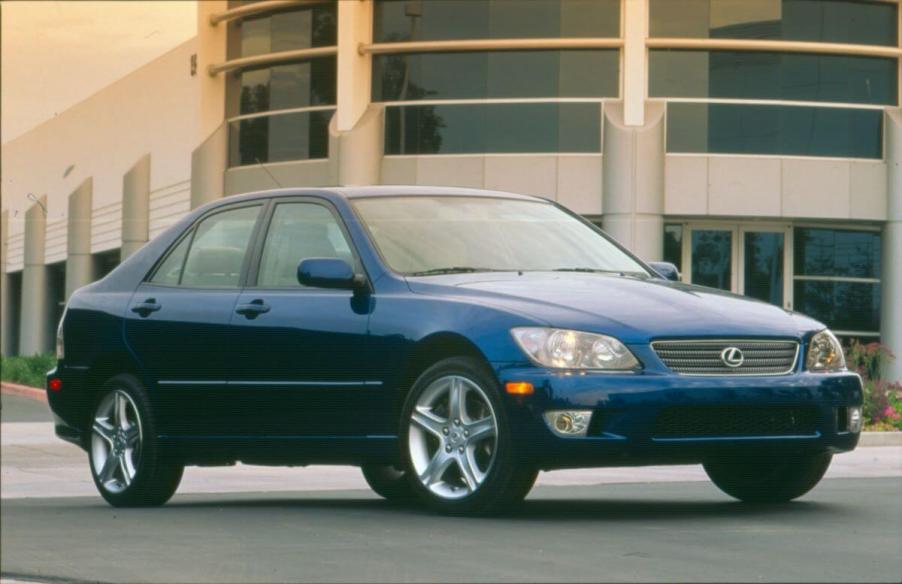
The Original Lexus IS 300: A Supra-Engined Reliable BMW
With the launch of the LS 400, Lexus showed how serious Toyota was about competing with the luxury German brands. However, it wasn’t enough to rival them in comfort and reliability. The Japanese automaker wanted something to rival BMW’s famed 3 Series. The result was the first-gen Lexus IS 300, a sports sedan with the heart of a Supra.
2001-2005 Lexus IS 300 specs and features
Originally, the Lexus IS was sold as the 1998 Toyota Altezza in Japan, MotorTrend reports. It would make its way over to the U.S. in 2001 with two available trims. The first, the IS 200, has the same 2.0-liter four-cylinder engines as the Altezza. The 2001 Lexus IS 300, though, has something a bit more potent.
The Lexus IS 300 has a 3.0-liter six-cylinder engine known as the 2JZ-GE. MkIV Supra fans should be familiar with that engine code. Although it didn’t have turbos and had a few internal changes, it was essentially the same engine found in the Toyota Supra. This was, incidentally, an engine that the JDM Altezza never offered.
Without turbos, the Lexus IS 300 doesn’t make as much power as the Supra—only 215 hp and 218 lb-ft. At least, that’s the stock output. It’s not unusual to see owners swap Supra turbos onto their Lexus IS 300s. The 2JZ is iconic precisely because of how overbuilt it was, Jalopnik explains. This was the end of the Bubble Era, which gave the world the Skyline GT-R and Autozam AZ-1. With the proper tuning, owners could theoretically triple the IS 300’s output without issue.
In addition to the 2JZ, the Lexus IS 300 is also rear-wheel drive. Starting in 2002, a five-speed manual transmission and a wagon variant, the SportCross, also became available. However, the SportCross itself is automatic only.
There were also the TRD-tuned Lexus IS 300 L-Tuned models, MT reports. Stage I cars have a body kit, fog lamps, and a stainless-steel exhaust that adds 8 hp. Stage II models add on new springs, larger anti-roll bars, cast-aluminum wheels, and Michelin Pilot Sport tires. They also ride 1 inch lower. Additionally, a limited-slip rear differential was available as an option.
How does the first-gen Lexus IS 300 drive?
In addition to receiving the MkIV Supra’s engine, the Lexus IS 300 was partially developed by its chief engineer, Nobuaki Katayama, according to Autotrader. Katayama also developed the famed AE86 Corolla and helped design World Rally Championship and Le Mans race cars. As such, the handling of the IS 300 delivers.
MotorTrend called its balance and steering feel “outstanding.” The five-speed manual’s shift action is solid, and the clutch is easy to live with. Plus, it’s still a Lexus. The leather seats are comfortable and supportive, and the plastics are of good quality. You could also order the IS 300 with a navigation system. In contrast, the chronometer-style gauges can be a bit difficult to read, but they’re certainly unique.
Regarding acceleration, the BMW 330i and 330i ZHP are faster to reach 60 mph. MT reports that the manual Lexus IS 300 can do 0-60 mph in about 6.6 seconds. The 330i, meanwhile, with its 225-hp 3.0-liter six-cylinder, could do it in 6.1 seconds. The ZHP was even faster, with an extra 10 hp and a six-speed manual. However, the IS 300 was lighter than even the 185-hp 320i by 115 pounds.
Pricing and common issues with the original IS 300
The 2001-2005 Lexus IS 300 isn’t particularly problematic, CarComplaints reports. The only real problem is the infamous melting dashboard that many other contemporary Lexus and Toyota models suffered.
The only problems MotorTrend suffered during its long-term test of a 2001 model came from damage caused by inattentive driving. Still, the 2002 and later model years are recommended due to a few surfaces getting more durable material upgrades. As for the 2JZ engine, the only issue is ensuring the timing belts are changed at least every 100,000 miles.
Unfortunately, because of that 2JZ engine and the RWD drivetrain, many first-gen Lexus IS 300s were modified over the years. As such, finding clean stock models can be tricky. They’ve also held their value arguably better than the E46. One in decent condition can go for almost $16,000 on Bring a Trailer, though $11,000 is closer to the average cost. However, the more unique SportCross models tend to cost $14,000-$16,000.




